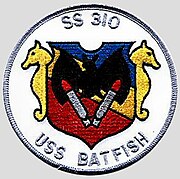
| |
| History | |
|---|---|
| Name | Batfish |
| Namesake | Batfish |
| Ordered | 21 April 1942 |
| Builder | Portsmouth Naval Shipyard, Kittery, Maine[1] |
| Laid down | 27 December 1942[1] |
| Launched | 5 May 1943[1] |
| Sponsored by | Mrs. Nellie W. Fortier |
| Commissioned | 21 August 1943[1] |
| Decommissioned | 6 April 1946[1] |
| Recommissioned | 7 March 1952[1] |
| Decommissioned | 1 November 1969[1] |
| Stricken | 1 November 1969[1] |
| Honors and awards | Presidential Unit Citation and 6 battle stars for World War II |
| Status | Museum ship in Muskogee, Oklahoma, 18 February 1972[2] |
| Badge |  |
| General characteristics | |
| Class and type | Balao class diesel-electric submarine[2] |
| Displacement | |
| Length | 311 ft 6 in (94.95 m)[2] |
| Beam | 27 ft 3 in (8.31 m)[2] |
| Draft | 16 ft 10 in (5.13 m) maximum[2] |
| Propulsion |
|
| Speed | |
| Range | 11,000 nautical miles (20,000 km) surfaced at 10 knots (19 km/h)[6] |
| Endurance |
|
| Test depth | 400 ft (120 m)[6] |
| Complement | 10 officers, 68 enlisted[6] |
| Armament |
|
The first USS Batfish (SS/AGSS-310) is a Balao-class submarine, known primarily for sinking three Imperial Japanese Navy submarines in a 76-hour period, in February 1945.[7] USS Batfish is the first vessel of the United States Navy to be named for the batfish, a type of anglerfish that crawls about on the sea floor.
Batfish served during World War II. Her war operations spanned a period from 11 December 1943 to 26 August 1945, during which she completed seven war patrols. She is credited with having sunk nine Japanese ships totaling 10,658 tons while operating east of Japan and in the Philippine Sea, Luzon Strait, and South China Sea. Batfish received the Presidential Unit Citation for her sixth war patrol during which she sank three Japanese submarines in the South China Sea in four days.
- ^ a b c d e f g h Friedman, Norman (1995). U.S. Submarines Through 1945: An Illustrated Design History. Annapolis, Maryland: United States Naval Institute. pp. 285–304. ISBN 1-55750-263-3.
- ^ a b c d e f g Bauer, K. Jack; Roberts, Stephen S. (1991). Register of Ships of the U.S. Navy, 1775-1990: Major Combatants. Westport, Connecticut: Greenwood Press. pp. 275–280. ISBN 0-313-26202-0.
- ^ a b c d e Bauer, K. Jack; Roberts, Stephen S. (1991). Register of Ships of the U.S. Navy, 1775–1990: Major Combatants. Westport, Connecticut: Greenwood Press. pp. 271–280. ISBN 978-0-313-26202-9.
- ^ U.S. Submarines Through 1945 pp. 261–263
- ^ a b c U.S. Submarines Through 1945 pp. 305–311
- ^ a b c d e f U.S. Submarines Through 1945 pp. 305-311
- ^ Don Keith, In the Course of Duty, p262, New American Library, ISBN 0-451-21659-8